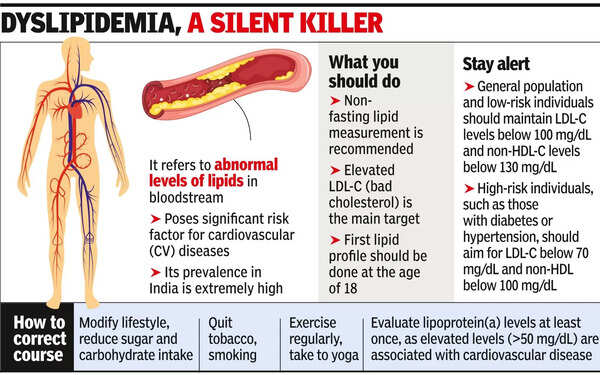- News
- City News
- delhi News
- Old enough to write CV? Get cholesterol tested too
Trending
Old enough to write CV? Get cholesterol tested too
The Cardiologist Society of India recommends cholesterol testing at age 18 with non-fasting measurements for accurate lipid profiling. Dyslipidemia poses a significant risk for heart disease in India, with tailored guidelines addressing unique characteristics. Lifestyle modifications are key for management, emphasizing exercise and healthy diet. High-risk patients advised to aim for specific LDL-C levels. Advanced treatments like PCSK9 inhibitors suggested for control. Genetic factors like familial hypercholesterolemia are common in India. Early detection and proactive management are crucial for maintaining heart health.

The recommendations form part of CSI's latest guidelines tailored for managing dyslipidemia in the Indian population.

Dyslipidemia, characterised by high total cholesterol, elevated LDL-cholesterol (bad cholesterol), high triglycerides, and low HDL-cholesterol (good cholesterol), is a critical risk factor for cardiovascular diseases such as heart attacks, strokes and peripheral artery disease.
The prevalence of dyslipidemia in India is alarmingly high, with significant interstate variations and particularly elevated rates in urban areas. Prevalence of dyslipidemia, a silent killer, in India is 81%, higher than hypertension (35%) and diabetes (11.5%), according to ICMR-INDIAB-17 study which was published in The Lancet in June 2023.
Dr JPS Sawhney, chairman of the department of cardiology at Sir Gangaram Hospital, stated that till now the European Society of Cardiology 2019 guidelines were adhered to worldwide. However, he pointed out that India has certain unique characteristics that are not found in other countries, such as the prevalence of lipid and low HDL levels. These distinctive features necessitate a tailored approach to managing cardiovascular health in the Indian population.
In India, half of all heart attacks occur in people under the age of 50. The likelihood of experiencing a cardiac event is heightened by various factors, including the use of tobacco products. Additionally, the presence of central obesity contributes to an increased risk. Dr Sawhney further noted that sedentary lifestyle and poor dietary habits exacerbate the problem.
The guidelines have been slightly modified compared to the European Society recommendations, taking into account the unique characteristics of the Indian community, said members of CSI.
“Aggressive targets are suggested for very high-risk patients, including those with a history of heart attacks, angina, stroke or chronic kidney disease,” Dr Sawhney said. “These patients should aim for LDL-C levels below 55 mg/dL or non-HDL levels below 85 mg/dL.”
Speaking about the severity of dyslipidemia, Dr Pratap Chandra Rath, the president of Cardiological Society of India (CSI), said: “Dyslipidemia is a silent killer, often symptomless unlike hypertension and diabetes. He stressed the importance of proactive management and early detection.
He said the guidelines recommend non-fasting lipid measurements for risk estimation and treatment, shifting from traditional fasting measurements.
Dr Durjati Prasad Sinha, honorary general secretary at CSI, highlighted, said: “Non-fasting lipid measurements make testing more convenient and accessible, encouraging more people to get tested and treated. The guidelines recommend the first lipid profile at the age of 18, or earlier with a positive family history of premature heart disease or familial hypercholesterolemia. The general population and low-risk individuals should maintain LDL-C levels below 100 mg/dL and non-HDL-C levels below 130 mg/dL. High-risk individuals should aim for LDL-C below 70 mg/dL and non-HDL below 100 mg/dL.”
Lifestyle modifications are emphasised as the cornerstone of dyslipidemia management. Reducing sugar and carbohydrate intake is recommended, as these contribute more to blockages compared to modest fat consumption. Regular exercise which offers cardioprotective benefits and are culturally relevant, and quitting alcohol and tobacco, are also recommended.
“High LDL-C and non-HDL-C can be controlled with a combination of statins and oral non-statin drugs. If goals are not achieved, injectable lipid-lowering drugs like PCSK9 inhibitors or Inclisiran are recommended,” said Dr S. Ramakrishnan, professor of cardiology at AIIMS, New Delhi, and co-author of the Lipid Guidelines.
“Genetic causes such as familial hypercholesterolemia, are more common in India than in other parts of the world,” said Dr Ashwani Mehta, senior consultant cardiologist at Sir Ganga Ram Hospital and co-author of the Lipid Guidelines.
End of Article
FOLLOW US ON SOCIAL MEDIA










